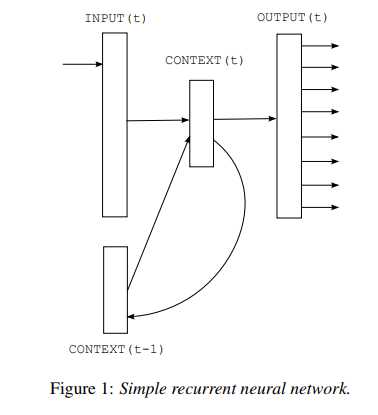标签:split() its www batch org res ret mil oss
论文通过实现RNN来完成了文本分类。
论文地址:88888888
模型结构图:

原理自行参考论文,code and comment:
1 # -*- coding: utf-8 -*- 2 # @time : 2019/11/9 15:12 3 4 import numpy as np 5 import torch 6 import torch.nn as nn 7 import torch.optim as optim 8 from torch.autograd import Variable 9 10 dtype = torch.FloatTensor 11 12 sentences = [ "i like dog", "i love coffee", "i hate milk"] 13 14 word_list = " ".join(sentences).split() 15 word_list = list(set(word_list)) 16 word_dict = {w: i for i, w in enumerate(word_list)} 17 number_dict = {i: w for i, w in enumerate(word_list)} 18 n_class = len(word_dict) 19 20 # TextRNN Parameter 21 batch_size = len(sentences) 22 n_step = 2 # number of cells(= number of Step) 23 n_hidden = 5 # number of hidden units in one cell 24 25 def make_batch(sentences): 26 input_batch = [] 27 target_batch = [] 28 29 for sen in sentences: 30 word = sen.split() 31 input = [word_dict[n] for n in word[:-1]] 32 target = word_dict[word[-1]] 33 34 input_batch.append(np.eye(n_class)[input]) 35 target_batch.append(target) 36 37 return input_batch, target_batch 38 39 # to Torch.Tensor 40 input_batch, target_batch = make_batch(sentences) 41 input_batch = Variable(torch.Tensor(input_batch)) 42 target_batch = Variable(torch.LongTensor(target_batch)) 43 44 class TextRNN(nn.Module): 45 def __init__(self): 46 super(TextRNN, self).__init__() 47 48 self.rnn = nn.RNN(input_size=n_class, hidden_size=n_hidden,batch_first=True) 49 self.W = nn.Parameter(torch.randn([n_hidden, n_class]).type(dtype)) 50 self.b = nn.Parameter(torch.randn([n_class]).type(dtype)) 51 52 def forward(self, hidden, X): 53 if self.rnn.batch_first == True: 54 # X [batch_size,time_step,word_vector] 55 outputs, hidden = self.rnn(X, hidden) 56 57 # outputs [batch_size, time_step, hidden_size*num_directions] 58 output = outputs[:, -1, :] # [batch_size, num_directions(=1) * n_hidden] 59 model = torch.mm(output, self.W) + self.b # model : [batch_size, n_class] 60 return model 61 else: 62 X = X.transpose(0, 1) # X : [n_step, batch_size, n_class] 63 outputs, hidden = self.rnn(X, hidden) 64 # outputs : [n_step, batch_size, num_directions(=1) * n_hidden] 65 # hidden : [num_layers(=1) * num_directions(=1), batch_size, n_hidden] 66 67 output = outputs[-1,:,:] # [batch_size, num_directions(=1) * n_hidden] 68 model = torch.mm(output, self.W) + self.b # model : [batch_size, n_class] 69 return model 70 71 model = TextRNN() 72 73 criterion = nn.CrossEntropyLoss() 74 optimizer = optim.Adam(model.parameters(), lr=0.001) 75 76 # Training 77 for epoch in range(5000): 78 optimizer.zero_grad() 79 80 # hidden : [num_layers * num_directions, batch, hidden_size] 81 hidden = Variable(torch.zeros(1, batch_size, n_hidden)) 82 # input_batch : [batch_size, n_step, n_class] 83 output = model(hidden, input_batch) 84 85 # output : [batch_size, n_class], target_batch : [batch_size] (LongTensor, not one-hot) 86 loss = criterion(output, target_batch) 87 if (epoch + 1) % 1000 == 0: 88 print(‘Epoch:‘, ‘%04d‘ % (epoch + 1), ‘cost =‘, ‘{:.6f}‘.format(loss)) 89 90 loss.backward() 91 optimizer.step() 92 93 94 # Predict 95 hidden_initial = Variable(torch.zeros(1, batch_size, n_hidden)) 96 predict = model(hidden_initial, input_batch).data.max(1, keepdim=True)[1] 97 print([sen.split()[:2] for sen in sentences], ‘->‘, [number_dict[n.item()] for n in predict.squeeze()])
pytorch --Rnn语言模型 -- 《Recurrent neural network based language model》
标签:split() its www batch org res ret mil oss
原文地址:https://www.cnblogs.com/dhName/p/11826541.html